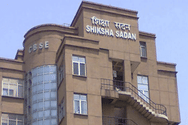- CBSE Class 10 Social Science Exam Pattern 2026 Revised
- CBSE Class 10 Social Science Exam Pattern 2026
- CBSE Class 10 Social Science Practical Blueprint 2026
- CBSE Class 10 Social Science Unit-wise Exam Pattern 2026
- CBSE Class 10 Social Science Question Paper Pattern 2026
- How to Use the CBSE 10th Social Science Exam Pattern …
- Faqs


Never Miss an Exam Update
CBSE Class 10 Social Science Exam Pattern 2026:
Understanding the CBSE Class 10 Social Science Exam Pattern 2026 is essential, as it allows you to plan your study schedule efficiently and prepare effectively for the board exams. By analyzing the exam pattern, you can identify the types of questions asked in each chapter and practice them accordingly. It also helps you allocate more time to chapters that carry higher marks and focus on the units with the greatest weightage. Managing your time while writing answers is equally important, so make it a habit to complete your responses within the time limit. Additionally, if a chapter mainly includes objective-type questions, focus on understanding the key concepts instead of spending too much time on detailed answer writing. Regularly solving previous years’ question papers and sample papers will further familiarize you with the exam format, enhance your accuracy, and boost your confidence before the final exam. The theory paper will be conducted for 80 marks and the remaining 20 marks are allotted for the practical exam. Along with that, section-wise marks are also allocated to map work and to the project work as well. Students can download the latest
CBSE Class 10 Social Science 2026 Syllabus
by visiting the official website of CBSE Academics and using it to plan out their studies accordingly.
Students can also check out
CBSE Class 10 Social Science Sample Paper 2026
to prepare for the final examination. The detailed
CBSE Class 10 Date Sheet 2026
is yet to be released. Check out more information about the CBSE Class 10 Social Science Exam Pattern 2026 here.
CBSE Class 10 Social Science Exam Pattern 2026 Revised
CBSE board had revised the class 10 social science and science exam pattern. From this year onwards, a total of 3 or 4 sections will be there in the final question of both subjects. For Social Science, the question paper has been divided into four sections: Section A, B, C, and D. Section A is History, Section B is Geography, Section C is Political Science and Section D is Economics.The 3 important instructions to be followed while appearing for the social science exam are -
- Students will have to divide the answer book into 4 sections in Social Science for writing answers.
- The answers should be written only within the space divided for the respective sections. Answers cannot be written in any other sections.
- Answers written in other sections will not be evaluated. 0 marks will be given to such answers. Such answers will not be checked or addressed during the revaluation process as well.
CBSE Class 10 Social Science Exam Pattern 2026
The syllabus for Social Science is divided into four parts to be studied by the students in detail. Check out the CBSE Class 10 Social Science Blueprint presented by board for the academic year 2026 from the table given below:
History (India and the Contemporary World - II) | ||||||||||||||
|---|---|---|---|---|---|---|---|---|---|---|---|---|---|---|
Section | Chapter No. | Chapter Name | No. of Periods | Marks Allocated | ||||||||||
I. Events and processes | I | The Rise of Nationalism in Europe | 17 | 18 + 2 map pointing * | ||||||||||
II | Nationalism In India | 17 | ||||||||||||
II. Livelihoods, Economies and Societies | III | The Making of a Global World (To be evaluated in the Board Examination - Subtopics:1 to 1.3 Pre Modern World to Conquest, Disease and Trade) | 6 | |||||||||||
Interdisciplinary project as part of multiple assessments (Internally assessed for 5 marks Sub topics 2 to 4.4 The nineteenth century (1815-1914) to end of Bretton Woods & the beginning of “Globalisation.” | 4 | |||||||||||||
IV | The Age of Industrialization (To be assessed as part of Periodic Assessments only) | 6 | ||||||||||||
III. Everyday Life, Culture and Politics | V | Print Culture and the Modern World | 10 | * Marks as mentioned above | ||||||||||
Geography (Contemporary India - II) | ||||||||||||||
Chapter No. | Chapter Name | No. of Periods | Marks allocated | |||||||||||
1. | Resources and Development | 7 | 17 + 3 map pointing | |||||||||||
2. | Forest and Wildlife Resources | 7 | ||||||||||||
3. | Water Resources | 7 | ||||||||||||
4. | Agriculture | 10 | ||||||||||||
5. | Minerals and Energy Resources | 10 | ||||||||||||
6. | Manufacturing Industries | 10 | ||||||||||||
7. | Lifelines of the National Economy Only map pointing to be evaluated in the Board Examination | 2 | ||||||||||||
Interdisciplinary project as part of multiple assessments (Internally assessed for 5 marks) | 2 | |||||||||||||
Political Science (Democratic Politics - II) | ||||||||||||||
Unit no | Chapter No | Chapter Name | No. of Periods | Marks allocated | ||||||||||
I | 1 | Power - sharing | 15 | 20 | ||||||||||
2 | Federalism | |||||||||||||
II | 3 | Gender, Religion, and Caste | 12 | |||||||||||
III | 4 | Political Parties | 12 | |||||||||||
IV | 5 | Outcomes of Democracy | 11 | |||||||||||
Economics (Understanding Economic Development) | ||||||||||||||
Chapter No. | Chapter Name | No. of Periods | Marks allocated | |||||||||||
1. | Development | 12 | 20 | |||||||||||
2. | Sectors of the Indian Economy | 12 | ||||||||||||
3. | Money and Credit | 12 | ||||||||||||
4. | Globalization and The Indian Economy To be evaluated in the Board Examination: What is Globalization? Factors that have enabled Globalisation | 8 | ||||||||||||
Interdisciplinary project as part of multiple assessments (Internally assessed for 5 marks) · Production across the countries · Chinese toys in India World Trade Organisation The Struggle for a Fair Globalisation | 6 | |||||||||||||
5. | Consumer Rights (Project Work) | |||||||||||||
Also Read: CBSE Class 10 Social Science Previous Year Question Papers
CBSE Class 10 Social Science Practical Blueprint 2026
The practical exam will be conducted for 20 marks in CBSE Class 10 Social Science. Students can refer to the exam pattern for the same from the table given below:
Type of Assessment | Description | Marks Allocated |
|---|---|---|
Periodic Assessment | Pen Paper Test. | 5 |
Multiple Assessment | Quiz, debate, role play, viva, group discussion, visual expression, interactive bulletin boards, gallery walks, exit cards, concept maps, peer assessment, Self-assessment, etc. through Interdisciplinary project | 5 |
Subject Enrichment Activity | Project Work on Consumer Rights OR Social Issues OR Sustainable Development | 5 |
Portfolio | Classwork, Work done (activities/ assignments) reflections, narrations, journals, etc. Achievements of the student in the subject throughout the year. Participation of the student in different activities like the Heritage India quiz | 5 |
Also Read: CBSE Class 10 Social Science Important Questions 2026
CBSE Class 10 Social Science Unit-wise Exam Pattern 2026
The table below presents the CBSE Class 10 Social Science Unit-Wise Marking Scheme 2026, which helps you understand the weightage of each unit in the exam. By reviewing it, you can see how many marks are allotted to each unit and plan your preparation accordingly, focusing more on the sections that carry higher marks to maximise your overall score.
Topics/ Units | Marks Allotted | Weightage (%) |
|---|---|---|
History – India and the Contemporary World – II | 20 marks | 25% |
Geography – Contemporary India – II | 20 marks | 25% |
Political Science – Democratic Politics – II | 20 marks | 25% |
Economics – Understanding Economic Development | 20 marks | 25% |
Total | 80 Marks | 100% |
CBSE Class 10 Social Science Question Paper Pattern 2026
There is a proper question paper pattern that the CBSE will follow to frame the board question paper. Students can refer to the information from the table given below:
Type of Questions | Marks (80) | Percentage |
|---|---|---|
1 Mark MCQs (20x1) | 20 | 25% |
(Inclusive Of Assertion, Reason, Differentiation & Stem) | ||
2 Marks Narrative Questions (4x2) | 8 | 10% |
(Knowledge, Understanding, Application, Analysis, Evaluation, Synthesis & Create) | ||
3 Marks Narrative Questions (5x3) | 15 | 18.75% |
(Knowledge, Understanding, Application, Analysis, Evaluation, Synthesis & Create) | ||
4 Marks Case Study Questions (3x4) | 12 | 15% |
(Knowledge, Understanding, Application, Analysis, Evaluation, Synthesis & Create) | ||
5 Mark Narrative Questions (4x5) | 20 | 25% |
(Knowledge, Understanding, Application, Analysis, Evaluation, Synthesis & Create) | ||
Map Map Pointing | 5 | 6.25% |
Also Read: CBSE Class 10 Result 2026
How to Use the CBSE 10th Social Science Exam Pattern 2026?
Here’s how the CBSE Class 10 Social Science Exam Pattern 2026 can help you score better:- Understand the paper structure: Learn how many questions are asked from each section and the types of questions included.
- Give equal attention to all units: Each of the four units carries 20 marks, so balance your preparation accordingly.
- Practice different question types: Solve MCQs, short answers, and long answers based on their marks and frequency in the paper.
- Prepare map-based questions carefully: These questions carry 5 marks and appear in both History and Geography sections.
- Improve time management: Use the exam pattern to plan how much time to spend on each section during practice and the final exam.
- Revise strategically : Focus on the weightage of each unit to ensure you don’t miss out on important topics or chapters.
CBSE Class 10 Social Science Exam Pattern 2026 is an important resource for students to plan their studies for the upcoming exams. According to CBSE, class 10th board exams will commence on 15th February 2026 so the students must start planning out their studies accordingly.
Are you feeling lost and unsure about what career path to take after completing 12th standard?
Say goodbye to confusion and hello to a bright future!

FAQs
Students must first complete their NCERT to prepare for the CBSE Class 10 Social Science Exam 2026. After completing the prescribed book, students can move on to side books such as All in One or Arihant.
Yes, the Central Board of Secondary Education has released the latest CBSE Class 10 Social Science Exam Pattern 2025-26 on the official website of CBSE Academics under the curriculum option present on the menu bar to be downloaded by the students.
To get full marks in the CBSE Class 10 Social Science Exam 2025-26, understand which topics carry more weight and focus on those while studying. Create a schedule that gives enough time to each topic, practice with old question papers, and write down important points for quick revision later. Lastly, stay calm and confident.
No major changes are recorded in the CBSE Class 10 Social Science Exam Pattern 2026. However, students must still download the latest curriculum PDF uploaded on the official website of CBSE Academics to prepare for the exams.
As per the CBSE Class 10 Social Science Exam Pattern 2024-25, the theory paper will be conducted for 80 marks and 20 marks will be allotted for the practical session. The curriculum is divided into four parts; each will consist of 20 marks in the question paper.
Was this article helpful?
























